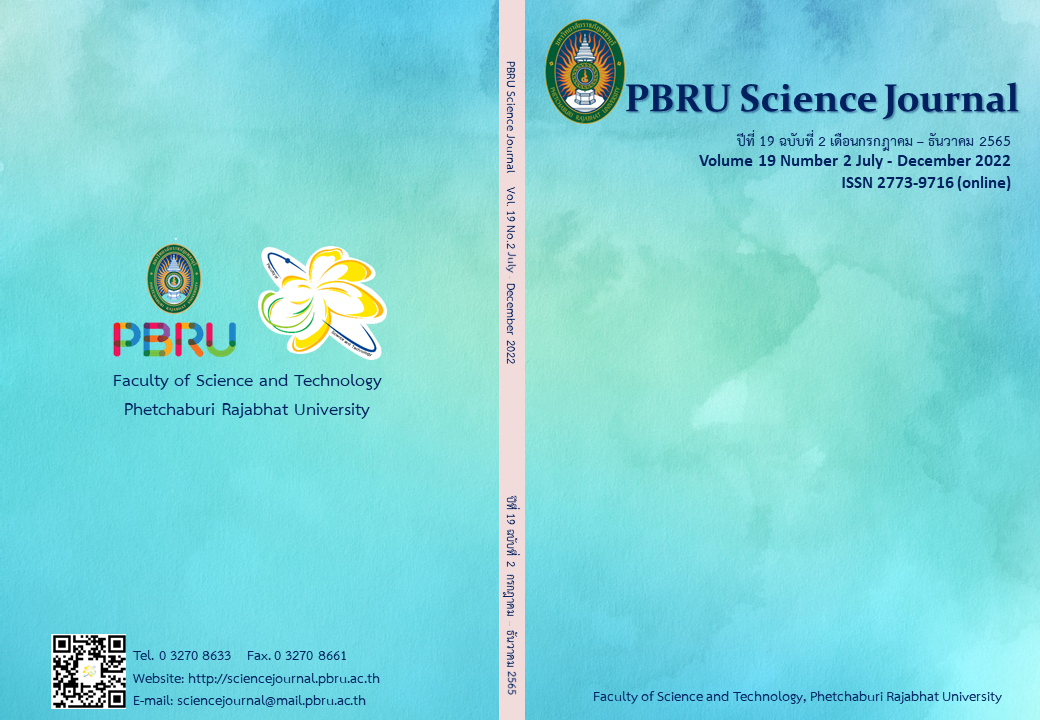ความสัมพันธ์ทางพันธุกรรมและประสิทธิภาพของยีน rbcL ในการจัดจำแนกกล้วยไม้ไทยจากแหล่งอนุรักษ์นอกถิ่นกำเนิด
Main Article Content
บทคัดย่อ
กล้วยไม้เป็นไม้ดอกเศรษฐกิจที่สำคัญชนิดหนึ่งของประเทศไทย เนื่องจากมีความสวยงามและความหลากหลายของสายพันธุ์สูง จึงจำเป็นต้องมีการจำแนกสายพันธุ์กล้วยไม้แต่ละชนิดออกจากกันได้อย่างถูกต้อง ในงานวิจัยนี้ได้ศึกษาความสัมพันธ์ทางพันธุกรรมและการระบุพันธุ์กล้วยไม้หายากด้วยลำดับดีเอ็นเอของยีน rbcL สำหรับนำไปประยุกต์ใช้เป็นเครื่องหมายบาร์โค้ดดีเอ็นเอเพื่อบ่งชี้ความแตกต่างของสายพันธุ์กล้วยไม้หายากได้ถูกต้อง โดยรวบรวมสายพันธ์กล้วยไม้หายากที่ปลูกไว้ที่แหล่งอนุรักษ์นอกถิ่น ณ หน่วยวิจัยชีววิทยาพืช มหาวิทยาลัยราชภัฏเพชรบุรี ผลวิจัยพบว่าจากการที่นำดีเอ็นเอของกล้วยไม้หายากจำนวน 30 ชนิด ไปเพิ่มปริมาณดีเอ็นเอโดยใช้ไพรเมอร์สำหรับเพิ่มปริมาณชิ้นดีเอ็นเอของยีน rbcL ในบริเวณส่วนหน้าของยีน ด้วยปฏิกิริยาลูกโซ่พอลิเมอเรส เมื่อนำดีเอ็นเอไปตรวจสอบและเปรียบเทียบกับฐานข้อมูล Genbank และสร้างแผนภูมิความสัมพันธ์ทางพันธุกรรม พบว่ามีลำดับดีเอ็นเอของกล้วยไม้จำนวน 9 ชนิด ยังไม่เคยมีรายงานลำดับดีเอ็นเอของยีน rbcL ในบริเวณนี้ ส่วนยีน rbcL ในกล้วยไม้ชนิดอื่นที่เคยมีรายงานแล้วนั้น พบว่ามีลำดับดีเอ็นเอที่ทำการศึกษาในครั้งนี้ความคล้ายคลึงกับลำดับในฐานข้อมูลไม่ต่ำกว่าร้อยละ 94 นอกจากนี้แผนภูมิความสัมพันธ์ทางพันธุกรรมที่ได้จากยีน rbcL ขนาดประมาณ 600 คู่เบส สามารถจัดกลุ่มของกล้วยไม้ในระดับเผ่าได้อย่างถูกต้อง ซึ่งแสดงให้เห็นว่าการใช้ตำแหน่งดีเอ็นเอส่วนต้นของยีน rbcL สามารถจำแนกกล้วยไม้ไทยได้อย่างน้อย 30 ชนิด และคาดว่าสามารถนำไปใช้ในการศึกษาต่อไปได้ในอนาคต
Article Details

อนุญาตภายใต้เงื่อนไข Creative Commons Attribution-NonCommercial-NoDerivatives 4.0 International License.
บทความที่ได้รับการตีพิมพ์เป็นลิขสิทธิ์ของ PBRU Science Journal
เอกสารอ้างอิง
Thammasiri K. Thai Orchid Genetic Resources and Their Improvement. Horticulturae 2016;2:9.
Chamchumroon V, Suphuntee N, Tetsana N, Poopath M, Tanikkool S. Threatened Plants in Thailand. Bangkok: Omega Printing; 2017.
Hebert PDN, Gregory TR. The promise of DNA barcoding for taxonomy. Syst Biol 2005;54:852-9.
Kress WJ, Erickson DL. A two-locus global DNA barcode for land plants: the coding rbcL gene complements the non-coding trnH-psbA spacer region. PLOS 2007;2:e508.
Ratnasingham S, Hebert PDN. BOLD: The Barcode of Life Data System. Mol Eco Notes 2007;7:355-64.
CBOL Plant Working Group. A DNA Barcode for Land Plants. Proceedings of the National Academy of Sciences of the United States of America 2009;106:12794-7.
Soltis DE, Soltis PS. Choosing an approach and an appropriate gene for phylogenetic analysis, pp.1-42, In Soltis DE, Soltis PS, Doyle JJ. (Eds.), Molecular Systematics of Plants II: DNA Sequencing. Boston: Kluwer Academic Publishers; 1998.
Bremer B, Manen JF. Phylogeny and classification of the subfamily Rubioideae (Rubiaceae). Plant Syst Evol 2000;225:43-72.
Ho VT, Tran TKP, Vu TTT, Widiarsih S. Comparison of matK and rbcL DNA barcodes for genetic classification of jewel orchid accessions in Vietnam. J Genet Eng Biotechnol 2021;19:93.
Wikström N, Kenrick P. Evolution of Lycopodiaceae (Lycopsida): Estimating Divergence Times from rbcL Gene Sequences by Use of Nonparametric Rate Smoothing. Mol Phylogenet Evol 2001;19:177-86.
Doyle JJ, Doyle JL. A rapid DNA isolation procedure for small quantities of fresh leaf tissue. Phytochem Bulletin 1978;19:11-5.
Sambrook J, Fritsch EF, Maniatis T. Molecular Cloning: A Laboratory Manual, 2ndEd. New York: Cold Spring Harbor Laboratory; 1989.
Fay MF, Swensen SM, Chase MW. Taxonomic affinities of Medusagyne oppositifolia (Medusagynaceae). Kew Bulletin 1997;52:111-20.
Reeves G, Chase MW, Goldblatt P, Rudall P, Fay MF, Cox AV, Lejeune B, Souza-Chies T. Molecular Systematics of Iridaceae: Evidence from Four Plastid DNA Regions. Am J Bot 2001;88:2074–87.
Kumar S, Stecher G, Tamura K. MEGA7: Molecular Evolutionary Genetics Analysis Version 7.0 for Bigger Datasets. Mol Biol Evol 2016;33:1870-4.
Govaerts R, Dransfield J, Zona S, Hodel DR, Henderson A. World Checklist of Orchidaceae. Facilitated by the Royal Botanic Gardens. [internet]. 2014 [cited 2017 June 25] Available from: http://wcsp.science.kew.org.
Dressler RL. The orchids: natural history and classification. Massachusetts: Harvard University Press; 1990.
Schuiteman A, Vermeulen JJ, de Vogel F. Flora Malesiana: Orchids of New Guinea, Volume 6: Genus Bulbophyllum. Leiden: The National Herbarium of the Netherlands; 2010.
Pedersen HE, Kurzeil H, Suddee S, de Vogel F, Cribb PJ, Chantanaorrapint S, Watthana S, Gale SW, Seelanan T, Suwanphakdee C. Flora of Thailand, Volume 12, Part 1, Orchidaceae (Cypripedioideae, Orchidoideae, Vanilloideae). Bangkok: The Forest Herbarium, Department of National Parks, Wildlife and Plant Conservation; 2011.
Pedersen HE, Kurzeil H, Suddee S, de Vogel F, Cribb PJ, Chantanaorrapint S, Watthana S, Gale SW, Seelanan T, Suwanphakdee C. Flora of Thailand, Volume 12, Part 2: Orchidaceae 2 (Epidendroidee P.P.: Neottieae, Tropidieae, Nervilieae, Gastrodieae, Thaieae, Calypsoeae, Arethuseae, Collabieae, Cymbidieae). Bangkok: The Forest Herbarium, Department of National Parks, Wildlife and Plant Conservation; 2014.
Schuiteman A, de Vogel F. Flora Malesiana: Orchids of New Guinea, Volume 2: Dendrobium and Allied Genera. Leiden: The National Herbarium of the Netherlands (NHN); 2002.
El-Sherif N, and Ibrahim M. Implications of rbcL and rpoC1 DNA Barcoding in Phylogenetic Relationships of some Egyptian Medicago sativa L. Cultivars. Egypt J Bot 2020;60:451-60.
Cameron K, Chase M, Whitten W, Kores P, Jarrell D, Albert V, Yukawa T, Goldman H. A Phylogenetic Analysis of the Orchidaceae: Evidence from rbcL Nucleotide Sequences. Am J Bot 1999;86:208-24.
Chase MW, Cameron KM, Freudenstein JV, Pridgeon AM, Salazar GA, Berg C, Schuiteman A. An updated classification of Orchidaceae. Bot J Linn Soc 2015;177:151-74.
Carlsward BS, Whitten W, Williams NH, Bytebier B. Molecularphylogenetics of Vandeae (Orchidaceae) and the evolution of leaflessness. Am J Bot 2006;5:770-86.
Stpiczynska M, Davies KL, Kaminska M. Comparative anatomy of the nectary spur in selected species of Aeridinae (Orchidaceae). Ann Bot 2011;107:327-45.
Fay MF, Chase MW. Orchid biology: From Linnaeus via Darwin to the 21st. century. Ann Bot 2009;104:359-64.
Simson MG. Plant Systematics, 2nd Ed. Boston: Elsevier, Academic Press; 2012.

